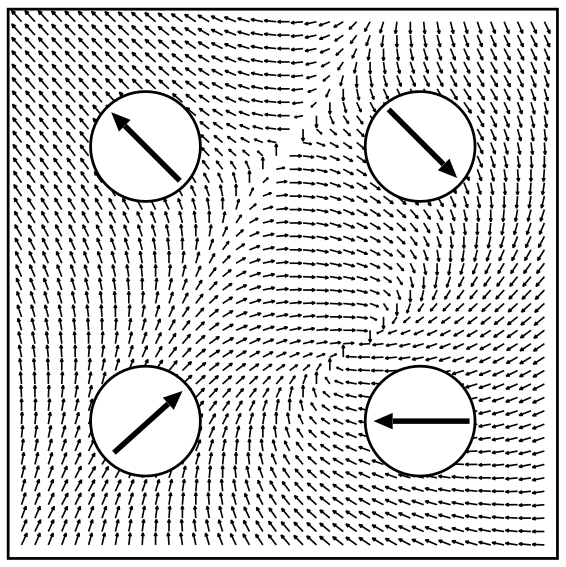Treatment of noncollinear magnetism
In the case of noncollinear magnetism, the Kohn-Sham equation obtains the form
where is the unit-matrix. The kinetic energy part of the Hamiltonian is diagonal in the two-dimensional spin space. Only the off-diagonal part of the hermitian potential matrix
couples the two components of the Pauli spinor . It is obtained from the density matrix, , that is given by a very simple relation in terms of the solutions of the Kohn-Sham equation, :
It is related to the density and magnetization by
where is the unit-matrix in spin-space and is the vector of the Pauli matrices.
The parametrization of calculations with noncollinear magnetism requires several optional tags
in the Fleur input file. To generate templates for these tags the input generator should be
invoked with one of the command-line options -noco or -explicit. This will generate
a nocoParams section within the calculationSetup block and further nocoParams
tags in each atomGroups/atomGroup. In the Fleur input file a noncollinear calculation is
activated by setting the calculationSetup/magnetism/@l_noco switch to T.
Note, that in a non-collinear calculation you can monitor the convergence of all
three parts of the density matrix, the two diagonal ones (spin 1 and 2) and one
of the off-diagonals (spin 3). In non-collinear calculations core-tail corrections
have to be switched off: calculationSetup/coreElectrons/@ctail has to be set to F.
When performing calculations with noncollinear magnetism in Fleur the magnetization in the interstitial region is treated as a continuous vector field while in the MT spheres the magnetization is approximated to be collinear and pointing in a fixed direction. Only the magnitude of the magnetization may change within a MT sphere. This is a reasonable approach for transition metals with small spin-orbit effects. The following figure illustrates this approach.

Illustration of the treatment of noncollinear magnetism in Fleur. Image taken from: Philip Kurz, Non-Collinear Magnetism at Surfaces and in Ultrathin Films (PhD Thesis, RWTH Aachen).
In the Fleur input file the direction of the magnetization in the muffin-tin spheres is specified w.r.t. the global frame for
the representative atom of each atomGroup in the associated enclosed nocoParams tag.
The spin-quantization axis (SQA) is provided by the angles (azimuthal angle similar to in the context of SOC) and (polar
angle similar to ). The example below demonstrates the nocoParams for some atom group with
defined and .
<nocoParams l_relax="F" alpha="Pi/2.0" beta="Pi/4.0"
b_cons_x="0.0" b_cons_y="0.0"/>
Assume that there are two symmetry equivalent atoms in the same atomGroup of a unit cell, then setting
and describes an antiferromagnetic structure.
In detail the angles and define the direction of the exchange field in the atoms at the start of a self-consistency step. After the diagonalization, the resulting charge density is not necessarily collinear in the muffin-tin spheres and even the average magnetization direction can point away from the defined SQA. It can happen (e.g. due to symmetry) that the magnetization stays in the direction of the SQA, but generally this will not be the case.
To consider the full non-collinear output magnetization density (also in the MT spheres) for a plot the
switch calculationSetup/nocoParams/@l_mperp has to be set to T. Afterwards one has to follow the normal
plotting procedure for a density.
Note that if spin-orbit coupling is considered together with noncollinear magnetism, i.e., calculationSetup/soc/@l_soc is
set to T, spin-orbit coupling is already treated in first variation. In this case calculationSetup/cutoffs/@numbands
is not a relevant cutoff parameter.
Due to an ongoing generalization of the treatment of noncollinear magnetism the following calculation modes are temporarily not functional in the Fleur MaX release 4.0. They will be reactivated in future releases.
Besides just keeping the angles and fixed there are two optional calculation modes that deal with output magnetization directions in the MT spheres that do not conicide with the input directions:
- Adjusting the SQA in the direction of the output magnetization
- Constraining the magnetization to the direction of the specified SQA
In both cases, it is necessary to know the component of the output magnetization that is perpendicular to the SQA.
This is obtained by setting calculationSetup/nocoParams/@l_mperp to T.
In the first case, the relaxation of the magnetic moments, it is then sufficient
to set for the respective atom groups atomGroup/nocoParams/@l_relax to T.
After each iteration and are adjusted to the output magnetization,
if the mixing parameter calculationSetup/nocoParams/@mix_b is set to 1.0 completely, for
smaller parameters an intermediate direction is taken (zero means no relaxation). Be aware that
such a relaxation can lead to slow convergence, sometimes it helps to remove the mixing_history from time to time.
For the case of constraining the magnetization one has to set the switch calculationSetup/nocoParams/@l_constr
to T. Then, a constraining field is calculated for each atom
which is then added to the effective field . The
ratio of perpendicular magnetization, and magnetization
along the SQA, , is proportional to the true constraining field
but the value has to be determined self consistently (with being the
mixing factor mix_b).
For each atom group the values of the constraining field are written as atomGroup/nocoParams/@b_cons_x
and atomGroup/nocoParams/@b_cons_y in the inp.xml file for the next iteration.
